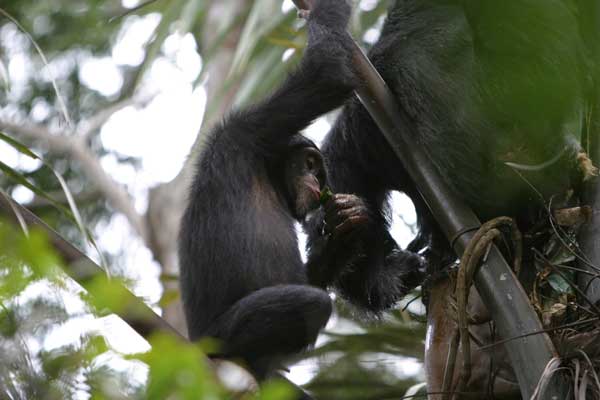Tools to tipple: ethanol ingestion by wild chimpanzees using leaf-spongesKimberley J. Hockings, Nicola Bryson-Morrison, Susana Carvalho, Michiko Fujisawa, Tatyana Humle, William C. McGrew, Miho Nakamura, Gaku Ohashi, Yumi Yamanashi, Gen Yamakoshi and Tetsuro Matsuzawa African apes and humans have recently been found to share a genetic mutation that enables them to effectively metabolise ethanol1. The consumption of ethanol by modern-day humans is nearly universal, being found in every society with fermentable raw materials. However, aside from enforced ingestion in captive experiments or anecdotal observations in wild apes, the habitual and voluntary consumption of ethanol in this evolutionary radiation has been documented until now only in humans. In this research article published in the journal Royal Society Open Science2, a team of International scientists headed by Professor Matsuzawa of the Primate Research Institute at Kyoto University, Japan, provide the first empirical evidence of repeated and long-term ethanol ingestion by any ape in nature. Local people tap raffia palms and the sap collects in plastic containers, fermenting quickly (the sap contained an average presence of alcohol of 3.1% ABV but levels can be as high as 6.9% ABV). Wild chimpanzees at Bossou in Guinea harvest fermented sap from the raffia palm using elementary technology – a leafy tool as a sponge. This absorbent extractive tool was dipped into the small opening of the fermented palm sap container, then retrieved and put into the mouth for drinking. All age and sex classes ingested the fermented palm sap, but some of the chimpanzees consumed high quantities of alcohol. Kimberley Hockings from Oxford Brookes University in the UK and the Centre for Research in Anthropology (CRIA-FCSH/UNL) in Portugal, and lead author of the article said that
"some individuals were estimated to have consumed approximately 85ml of alcohol (the equivalent to 8.5 UK units) and displayed behavioural signs of inebriation, including falling asleep shortly after drinking. Our research demonstrates there is not a strict aversion to food containing ethanol in this chimpanzee community." This ability to use tools may have enabled the last common ancestor of living apes and humans to exploit difficult-to-reach fermented resources. ROYAL SOCIETY OPEN SCIENCE
http://dx.doi.org/10.1098/rsos.150150 
Peley drink palm wine. Photo by Gaku Ohashi
JUN/11/2015
Copyright(C) 2015 PRI ( ). ). |




